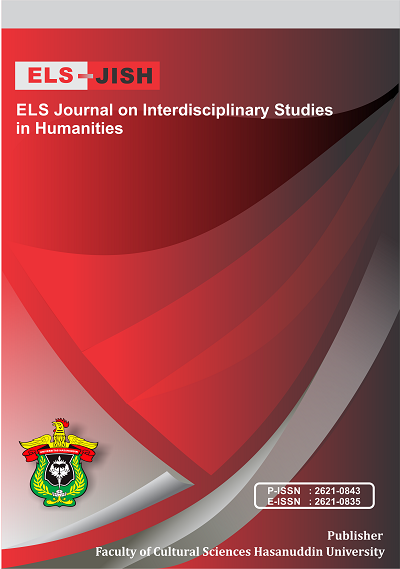The Preservation of Bugis Language in Sinjai City: A Sociolinguistic Perspective
DOI:
https://doi.org/10.34050/elsjish.v7i1.34115Keywords:
Bugis language, Sinjai City, language preservation, sociolinguistics, language vitalityAbstract
The Bugis language, belonging to the Austronesian family, serves as a crucial element of cultural identity and heritage for the Bugis ethnic group in Indonesia, particularly in Sinjai City. However, like many indigenous languages, Bugis faces challenges in preservation due to socio-cultural factors. This research delves into preservation efforts and sociolinguistic dynamics surrounding the Bugis language since 2000, aiming to provide insights for stakeholders. Drawing on qualitative methods, including semi-structured interviews and ethnographic observations, this study aims to explore the motivations driving preservation efforts, investigate the role of education, examine socio-cultural factors influencing language use, and assess the effectiveness of existing preservation strategies. Findings reveal that cultural identity maintenance, intergenerational transmission, and the desire to safeguard linguistic diversity are primary motivations. Education emerges as pivotal, though hindered by the dominance of Bahasa Indonesia and limited institutional support. Socio-cultural factors like urbanization, migration, media influence, and linguistic stigma further challenge preservation. Strengths of current strategies include community engagement and cultural affirmation, while limitations include lack of support and linguistic stigma. Recommendations for augmenting preservation efforts include advocating for policy reforms, community empowerment, digital resources, and promoting multilingualism. Ultimately, preserving the Bugis language entails a holistic approach that honors cultural diversity and empowers the Bugis community.
References
Amir, J. (2012). Revitalisasi Bahasa Bugis dan Makassar Sebagai Khasanah Kekayaan Lokal. Makalah pada Kongres Internasional II Bahasa-Bahasa Daerah Sulawesi Selatan.
Ammarell, G. (1999). Bugis Navigation. Southeast Asia Studies. New Haven, Connecticut: Yale University.
Ammarell, G. (2002). Bugis migration and modes of adaptation to local situations. Ethnology, 41(1), 51–67. https://www.jstor.org/stable/4153020
Andini, C., Yassi, A. H., & Sukmawaty. (2021). The use of honorifics in English and Buginese with special reference to bone language: A comparative study. International Journal of Innovative Science and Research Technology, 6(7), 873-877.
Appadurai, A. (1996). Modernity at large: Cultural dimensions of globalization. Minneapolis: University of Minnesota Press.
Arka, I. W. (2013). Language management and minority language maintenance in (eastern) Indonesia: strategic issues. Language Documentation and Preservation, 7, https://scholarspace.manoa.hawaii.edu/handle/10125/4568.
Bachriani, B., Yassi, A. H., & Rahman, F. (2018). A Comparative Study of Euphemism in English and Buginese: Pragmatic Stylistics Contexts. Parenting, 38, 5.
Blust, R. (2013). The Austronesian languages. Asia-Pacific Linguistics, 5. Canberra: Australian National University.
Budhi, S. (2015). Bugis Pagatan: Migration, Adaptation and Identity. IOSR Journal Of Humanities And Social Science (IOSR-JHSS), 20(5), 71-78.
Crystal, D. (2000). Language death. Cambridge. Cambridge University Press.
Darwis, M., & Kamsinah, K. (2019). Sumbangan Bahasa Indonesia Terhadap Pemekaran Kosakata Bahasa Bugis: Kasus Penggunaan Bahasa Bugis Pada Media Sosial Facebook (The Contribution of Indonesian Language on Buginese Vocabulary Development: A Case Study of The Use Of Buginese on Facebook Social Media). SAWERIGADING, 25(2), 107-118.
Fishman, J. A. (1991). Reversing language shift: Theoretical and empirical foundations of assistance to threatened languages. Clevedon: Multilingual Matters.
Gashilova, L. (2015). Education as a factor of preservation of languages and cultures of Northern indigenous peoples. Arctic Dialogue In The Global World.
Kachru, B. B. (1985). Standards, codification, and sociolinguistic realism: The English language in the outer circle. In R. Quirk & H. G. Widdowson (Eds.), English in the world: Teaching and learning the language and literatures (pp. 11–30). Cambridge: Cambridge University Press.
Paauw, S. (2009).One land, one nation, one language: An analysis of Indonesia’s national language policy. In H. Lehnert-Le Houillier & A.B. Fine (eds.), University of Rochester Working Papers in the Language Sciences, 5(1), 2-16.
Pennycook, A., & Otsuji, E. (2015). Metrolingualism: Language in the city. Routledge.
Pelras, C. (1996). The Bugis. Oxford: Blackwell Publishers.
Rahman, F., Akhmar, A. M., Hasyim, M., Dalyan, M., & Rahman, F. F. (2022). The Virtue In Core Values of Buginese Culture: A Worldview from Philosophical, Religious, and Moral Perspectives. Al-Qalam, 28(2), 197-207.
Rahman, F., & Weda, S. (2019). Linguistic deviation and the rhetoric figures in Shakespeare’s selected plays. XLinguage" European Scientific Language Journal", 12(1), 37-52.
Smith, J. (2018). Community-driven language education: A case study of language revitalization in Indigenous communities. Journal of Sociolinguistics, 42(3), 315-330.
Sukmawaty, S., Andini, C., & Rahman, F. F. (2022). The Shift of Honorifics due to The Promotion As A Government Official: Comparative Study. ELS Journal on Interdisciplinary Studies in Humanities, 5(1), 166-176.
Tahir, D., Rahman, F., & Rahman, A. (2018). The Study of Buginese Reciprocal Verb in the Boegineesche Chrestomathies Manuscript. Am. J. Humanit. Soc. Sci. Res, 2(08), 48-54.
Ting, S. H., & Ling, T. Y. (2013). Language use and sustainability status of indigenous languages in Sarawak, Malaysia. Journal of Multilingual and Multicultural Development, 34(1), 77-93.
Woolard, K. A., & Schieffelin, B. B. (1994). Language ideology. Annual Review of Anthropology, 23, 55–82
Downloads
Published
Issue
Section
License
Copyright (c) 2024 Nurhadi Hamka, Nurul Imansari, La Ode Achmad Suherman

This work is licensed under a Creative Commons Attribution-ShareAlike 4.0 International License.






